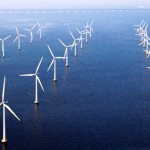 When it comes to “renewables” wreaking havoc on the environment, wind turbines have stiff competition. For example, over 500,000 square miles of biofuel plantations have already replaced farms and forests to replace a mere 4 percent of transportation fuel. Mining operations are scaling up to source raw materials to build “sustainable” batteries, with no end in sight, in nations with appalling labor conditions and nonexistent environmental regulations. But the worst offender is the wind industry.
When it comes to “renewables” wreaking havoc on the environment, wind turbines have stiff competition. For example, over 500,000 square miles of biofuel plantations have already replaced farms and forests to replace a mere 4 percent of transportation fuel. Mining operations are scaling up to source raw materials to build “sustainable” batteries, with no end in sight, in nations with appalling labor conditions and nonexistent environmental regulations. But the worst offender is the wind industry. 
America’s wind power industry somehow manages to attract almost no negative coverage in the press or litigation from environmentalists, despite causing some of the most obvious and tragic environmental catastrophes so far this century. Last August I wrote about the ongoing slaughter of whales off America’s northeast coast thanks to the construction of offshore wind turbines:
“When you detonate massive explosives, repeatedly drive steel piles into the ocean floor with a hydraulic hammer, and blast high decibel sonar mapping signals underwater, you’re going to harm animals that rely on sound to orient themselves in the ocean. To say it is mere coincidence that hundreds of these creatures have washed ashore, dead,  all of a sudden, during precisely the same months when the blasting and pounding began, is brazen deception.”
all of a sudden, during precisely the same months when the blasting and pounding began, is brazen deception.”
Nonetheless, when the story can’t be buried, deception is the strategy. Not one major environmental organization, government watchdog agency, or media outlet has called for a slowdown in industrial offshore wind projects. Instead, they repeatedly claim these allegations are misinformation. And from that paragon of truth, FactCheck.org, we get this: “No Evidence Offshore Wind Development Killing Whales.”
Let’s set aside the obvious negative impact on whale populations of tens of thousands of marine surveying and construction sorties into offshore areas where shipping traffic has never before been concentrated, or the impact of noise and explosions on not one site, such as would be the case with a lone oil rig, but on thousands of sites, each one being prepared for an offshore wind turbine. The destruction wrought by wind turbines extends well beyond what it’s doing to whales.
A report just released by a New England fishermen's association summarizes research they completed on offshore wind projects. Their findings are stunning. Just the geographic extent of these proposed offshore wind projects is unprecedented. According to the report, “Federal regulators at the Bureau of Ocean Energy Management (BOEM) have designated almost 10 million acres for wind farm surveys and development.” That is over 15,000 square miles.
Not included in that allocation are the corridors where high-voltage lines will have to cross the ocean floor to transfer electricity from the turbines to land-based power grids. The report found that “electromagnetic fields (EMFs) emanating from subsea cables appear to produce birth deformities in juvenile lobster.” That’s just the beginning.
The report also found that wind farms “increase sea surface temperatures and alter upper-ocean hydrodynamics in ways scientists do not yet understand,” and “whip up sea sediment and generate highly turbid wakes that are 30-150 meters wide and several kilometers in length, having a major impact on primary production by phytoplankton which are the base of marine food chains.” And there’s more.
Wind turbines “generate operational noise in a low-frequency range (less than 700 Hz) with most energy concentrated between 2 and 200 Hz. This frequency range overlaps with that used by fish for communication, mating, spawning, and spatial movement,” and “high voltage direct current undersea cables produce magnetic fields that negatively affect the drifting trajectory of haddock larvae by interfering with their magnetic orientation abilities.” Haddock is “a significant portion of U.S. commercial fish landings and are an important component of the marine food chain.”
Nothing to see here, right?
What’s going on off the coast of New England is being allowed to happen because of disgraceful negligence on the part of America’s environmentalist community. What’s about to happen in California is just as bad, and is proceeding without any organized opposition or serious criticism.
Earlier this year, the federal government leased 583 square miles of deep ocean waters off the coast of California for offshore wind farms. When the first phase of these offshore wind developments is completed, these wind farms will deliver 4.5 gigawatts of “clean” electricity to the California grid. That may sound like a lot of electricity. It’s not.
To begin with, even offshore wind only blows intermittently. The most optimistic projections for the actual yield of these turbines are never more than 50 percent. This means that in terms of baseload power, only 2.25 gigawatts will come from these new offshore wind farms. California’s average electricity consumption is 32 gigawatts (of which only 22 gigawatts are produced in-state), which means if these offshore wind farms are ever completed, they’ll supply a mere 6 percent of California’s current electricity demand – the same amount currently coming from Diablo Canyon, California’s last operating nuclear power plant. But how many turbines will this take, and what will they look like?
The biggest wind turbines in the world can now produce 10 megawatts at full output. To generate this much electricity, these machines are 1,000 feet tall, which is more than three times higher than the Statue of Liberty from the water line to the tip of the torch. To achieve a collective capacity at full output of 4.5 gigawatts, 450 of these would have to be built, floated 20 miles offshore, anchored to the seabed with cables nearly a mile long, then from each one a high voltage line would also have to descend 4,000 feet to reach the ocean floor, where it would then lie on the sea bed – some proposals actually call for them to be buried – to transmit electricity to the onshore power grid. Four hundred and fifty floating wind turbines, each one of them with vertical dimensions that are longer than a modern aircraft supercarrier. There are huge and unresolved engineering hurdles involved in developing large floating wind turbines.
Bear in mind, if California’s state legislature gets its way, and the state goes fully electric – think all space heaters, water heaters, dryers, along with all trucks, buses, and cars going fully electric – electricity demand will more than triple. While it’s hypothetical, the math is simple and revealing: to get 100 gigawatts of baseload power from offshore wind, you would need 20,000 turbines. And imagine all the high voltage distribution lines, and all the batteries to buffer the massive surges of intermittent power.
To somewhat return to reality, we must acknowledge that none of California’s enlightened planners intend to use offshore wind to generate 100 percent of California’s renewable electricity. But in one of the most reputable mainstream studies produced to date, a professor of civil and environmental engineering at Stanford University, Mark Jacobson, completed a series of simulations, culminating in a report released in December 2021 that called for 20 percent of California’s electricity to derive from offshore wind. Making more conservative assumptions regarding the size of each offshore turbine and the yield, he predicted more than 12,000 offshore wind turbines would be required.
Imagine the logistics.
How many ships will this take? How many submarines and divers? How many port facilities? How many new homes for the construction workers? What about the undersea power cables? What about the storage batteries needed to buffer nearly 20 gigawatts of on-again, off-again electricity? What about the ongoing maintenance? What about the raw materials needed to build all these leviathans? What about the billions and billions of dollars that will flow into the pockets of the special interests behind this disaster of a project, paid by taxpayers and ratepayers?
Overall, Jacobson’s study projected about one-third of California’s electricity to come from a combination of onshore and offshore wind turbines. Shall we reiterate what else we already know about wind turbines? Their slaughter of raptors, bats, and insects? Their incessant, low-frequency sound that is audible for miles and, despite “debunking” articles that defy basic common sense, drives people and animals nuts? The visual blight? The staggering quantity of materials required for their manufacture, and the difficult if not impossible task of recycling the materials after they’ve reached the end of their service life?
Where are the environmentalists?
Where, for that matter, are the economists? Is the mantra “climate crisis” so powerful that literally anything goes, including a scheme that delivers not only environmental but economic catastrophe? In 2020, an in-depth financial analysis by the Manhattan Institute documented how “offshore wind’s costs will far exceed its benefits.” And that was before the supply chain problems, inflation, and interest rate hikes that have forced offshore wind developers from New England to California to greatly increase required rates, or pull out of projects altogether.
Imagine if this was an oil rig, a desalination plant, or a nuclear power plant. The opposition would be apoplectic, and that is not hypothetical conjecture. California had a chance to build another major desalination plant which would have supplied 55,000 acre feet per year of drought-proof fresh water to the residents of Orange County, population 3 million. Along with other projects in the works, this desalination plant could have made that relatively arid coastal county utterly independent of imported water. But environmentalists fought the project at every turn, and in May 2022, in a unanimous vote, the California Coastal Commission denied the construction permit.
As for oil and gas, California’s state legislators are doing everything they can to destroy production in the state. Despite having massive reserves of oil and gas, Californians have to import more than 75 percent of their oil and more than 90 percent of their natural gas. And when it comes to nuclear power, the Diablo Canyon nuclear power plant, California’s last one, narrowly escapes regulatory shutdown every few years, despite being designed to operate well past the middle of this century.
The scandalous double standard at work here can only be attributed to a combination of powerful special interests representing the wind power industry, interacting with a state legislature and environmentalist movement that is either bought off or alarmingly stupid. As it is, hundreds of billions of taxpayer subsidies are on track to pay for offshore wind. If it is not stopped, it will be one of the most egregious cases of economic waste and environmental destruction in human history.
This article originally appeared in American Greatness.
Comments powered by CComment